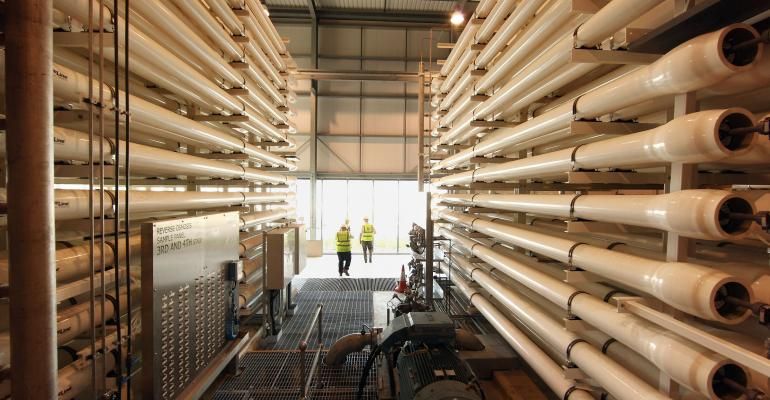Educating The General Public on Water-Energy Issues
Published on by Kelly L. Rodgers, Ph.D., P.E. in Social
Here's an example article to raise public awareness: With water responsible for one-fifth of its energy use, California bolsters the sector's green footprint.

An energy intensive desalination plant in the United Kingdom.
We grew up with the notion that water and electricity do not mix.
Today we know differently. The California Energy Commission 2005 California's Water-Energy Relationship Report recognizes that water and energy are very much connected. This relationship is called the “water-energy nexus.”
The combination of the energy used to treat and deliver water to customers and water-related energy use on the customer side of the meter constitute nearly 20 percent of the total electricity used in California, the report said.
The need to adapt to climate change and drought has promoted the development of local, drought resilient supplies such as seawater desalination and potable water reuse. While vital for water supply reliability, these water resources are also more energy intensive than conventional water resources.
Like water utilities, energy utilities face reliability challenges in terms of how to integrate renewable energy supplies into their portfolio to meet state mandated Renewable Portfolio Standard in a cost effective fashion.
California electric utilities are required to procure 50 percent of their energy supply portfolio from renewable energy sources such as wind and solar by 2030. There is a drive to increase the RPS to 100 percent by 2045, similar to Hawaii’s target.
Wind and solar are intermittent, so energy supply does not always align with energy demand. For instance, solar may be plentiful during the mid-day and wind may be plentiful in late evening when demands are low. These resources are wasted if they cannot be stored for use later when families are getting up and getting ready for the day or coming home in the evening and turning on appliances, air conditioning and heating.
These resource reliability and cost challenges are not the only things that water and energy utilities have in common. Both own large-scale transmission and distribution infrastructure that deliver water and power to the same ratepayers.
This similarity creates opportunities. Water utilities can use their existing infrastructure to generate clean energy, for instance, by installing turbines in flow control facilities. They also can use water reservoirs for pumped storage operations to absorb oversupply of wind and solar energy, so that electrical utilities don’t have to curtail renewable energy products.
Electrical utilities could compensate water utilities for the services these hydroelectric facilities provide. This is a win for both parties. Electrical utilities have resources to help meet RPS mandates and provide grid reliability, and water utilities receive revenue to offset operational costs that impact water rates.
Together, the water and energy sectors can help plan for climate change and meet state mandates that affect how business is done.
As we move into the future, it is increasingly important that water and energy leaders collaborate and build unique partnerships to ensure vital resources, water and energy, are available to meet demands and at the lowest possible cost.
It is also important that regulators and legislators recognize these challenges and opportunities, help to remove barriers, and allow water and energy agencies to work together for public good. Today, it is crystal clear that water and electricity do, in fact, mix.
Kelly Rodgers is the San Diego County Water Authority’s energy program manager.
Source: The Energy Times
Media
Taxonomy
- Treatment
- Resource Management
- Water-Energy Nexus
- Energy Efficiency
- Energy Efficiency
- Sustainable Desalination
- Water Resource Management
- Efficiency Improvement
- Energy Efficiency